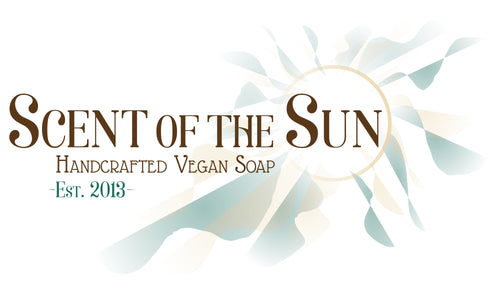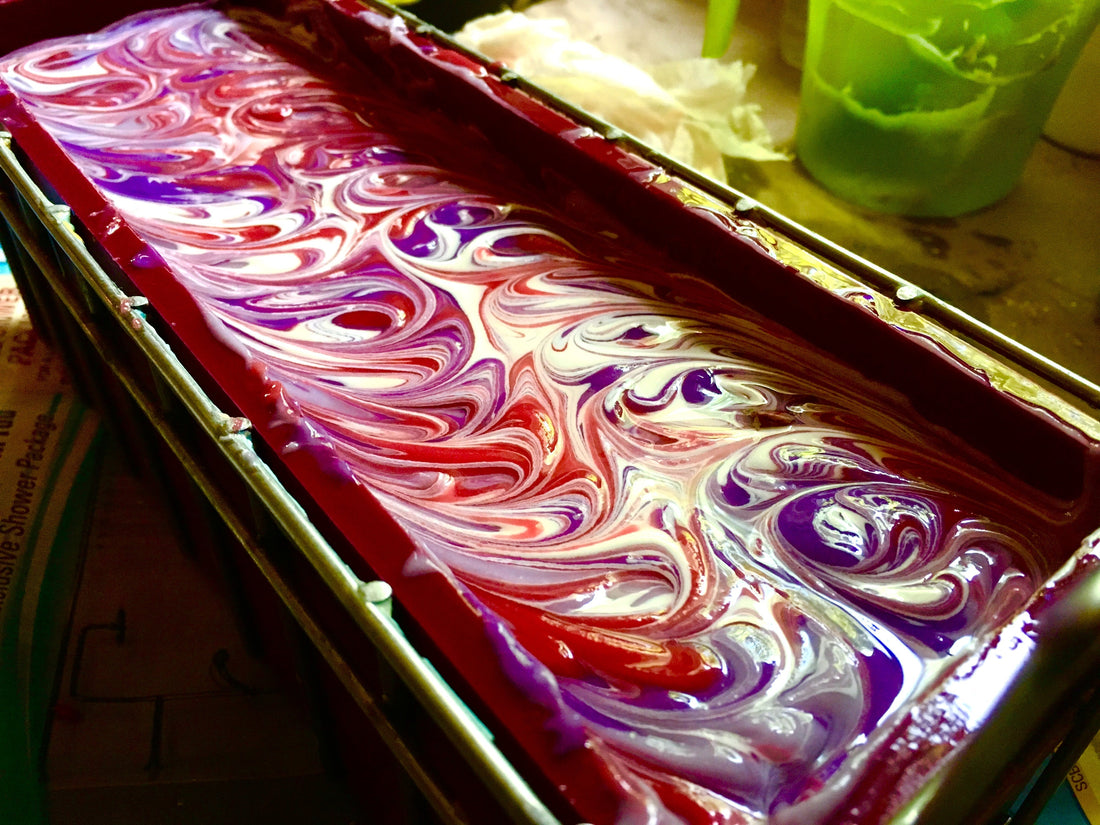This is the third post in our new blog, "Happy Accidents in Soapmaking." We hope readers will enjoy discovering just how much fun cold process soapmaking can be. Curious about the mother-and-son team at Scent of the Sun? Learn more.
 Soap isn’t just cleansing. It’s a canvas. Soapmaking is an artistic interplay of color, fragrance, and chemistry—and color design is possibly our favorite element of the equation. We do our best to make each of our bars as pleasing to look at as it is to smell, and in this article, we’ll take a look at how we recently swirled together the purples, maroons, and creams that make up our Huckleberry Harvest soap.
Soap isn’t just cleansing. It’s a canvas. Soapmaking is an artistic interplay of color, fragrance, and chemistry—and color design is possibly our favorite element of the equation. We do our best to make each of our bars as pleasing to look at as it is to smell, and in this article, we’ll take a look at how we recently swirled together the purples, maroons, and creams that make up our Huckleberry Harvest soap.
Handcrafting for Beauty
Each soap offers a unique opportunity for visual creativity, and the possibilities are limitless—and sometimes challenging. What colors express the scent of Honeysuckle? Which visual design evokes the look of fresh-brewed Coffee? Sometimes trying to answer those questions can be the most fun and frustrating aspects of soapmaking.
No matter what soap you’re making, however, it all begins with color. Our colors primarily come from micas: minerals coated in pigments. These come in a variety of shades, consistencies, and vibrances, but if you’ve seen the pigments used by oil painters, you might know what they look like:

Granted, our pigments go into Dixie cups, not onto artists’ palettes, but you get the point.
To incorporate them into our soaps, we mix the powders into olive oils, and then mix that oil into soap batter. We may also use other colorants such as titanium dioxide (for white and cream) and activated charcoal (for deep greys and blacks). From time to time, we even use other additives as well, ranging from turmeric and lemon peels to clay and olive leaves.

What can you do with color in a soap? You can dust unmixed micas over a layer of soap to make a “mica line.” You can see that in our Queen Crimson soap, which features a regal gold line between its two segments. You can layer color in gradients to create the vaguely mountainous look of our Chai Tea bars. Or you can plop colors of soap into one another to create a swirling effect—and to please your inner Jackson Pollock—as in our Harvest Son soap.
The only limit is your imagination.
We’re Your Huckleberry
When we designed the look of Huckleberry Harvest, we started with the fragrance itself. The aroma combines blueberries, raspberries, and grapes with slight hints of strawberries and peaches, and so we chose deep purple, light purple, and maroon to echo the shades of fruit—and cream to break up the colors and provide a pop of contrast.
With our colors chosen, we decided to make the soap a drop swirl to try to evoke an image of berries hanging fresh on the vine. A drop swirl is literally just that: a swirl of color created by elevating and dropping differently colored soap batters into one another.
To accomplish that, we prepared the soap in layers, beginning by pouring in soap batter with our base color—in this case, a light purple. Then we followed that by dropping differently colored batter within it, going from dark purple and cream to maroon—and back again. Midway, it all looked a bit like a canvas—an undulating liquid one that was rapidly saponifying, or turning into soap.

Abstract art… er, soap.
After dropping several more layers, we reached the top of the soap. Then we modified the swirl with a hanger to make it just a little more distinct. And by hanger, I mean just that—a wire hanger bent to fit a soap mold. You press the hanger into the soap, swirl it around a little, and voila—you have a drop hanger swirl.
The only thing left to do was to create our top with a little remaining mica and soap batter. To me, swirling colors on the top of a soap is one of my favorite pleasures of soapmaking. Every artisan tops their soaps in a different way, and each top is akin to a soapmaker’s signature. I tend to layer swirls under circular counterstrokes, but my mother Kay tends to focus more on pure swirls. It’s a personal choice—and a fun one.
Once we finished, it looked like this:

Glistening with color.
Watching Colors Come Forth

Ultimately, however, a top is just a top. What makes or breaks a bar of soap is how it all comes together, and each time you make soap, you roll the dice a little. Because different oils and fragrances interact in unpredictable ways, you never really know what the soap will look like in the end.
Will the colors hold? Does the internal swirl look good? You simply have to wait the 24 hours to pop it out of the mold, cut it, and see.
Happily for us, in the case of Huckleberry Harvest, the cut came out better than we could have hoped. With each stroke of our soap cutter, we saw a little more of our creation emerge. Shades of lilac, maroon, and purple burst forth in each bar.
Though the soaps still needed trimming, curing, and labeling, the colors they conjured were already apparent enough to bring a smile to our faces—and, we hope, to yours.

Huckleberry in bloom.
Rick Brown is one-third of the family-run vegan soap business that is Scent of the Sun. Learn more about us.


2 comments
These soaps are amazing. With so many choices it wasn’t hard too put in a (large) order. I’d have to say the black dragon or the teakwood and cardamom are my favorites, definitely worth checking out.
There are different kind of soap glycerin soap, transparent soap, liquid soap, kitchen soap, novelty soap, guest soap, and medicated soap. Soaps are substance used with for wash and cleaning, made of a compound of natural oils or fats with sodium hydroxide or another strong alkali, and typically having perfume and coloring added thanks for this article.